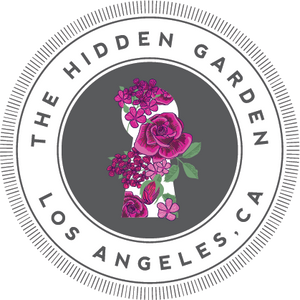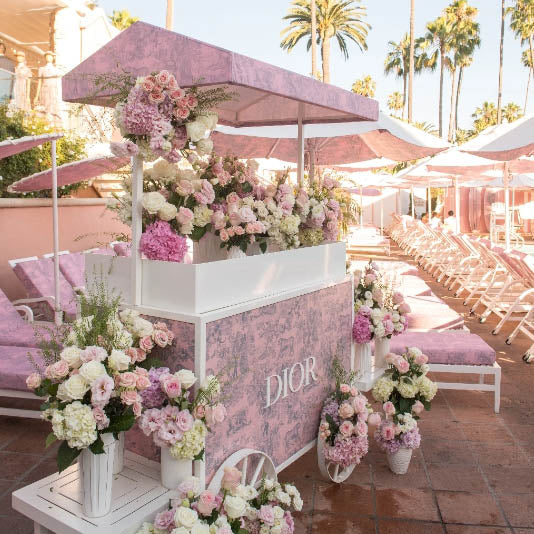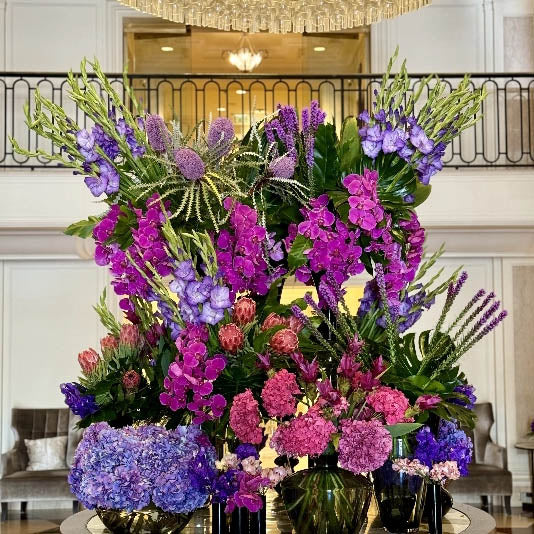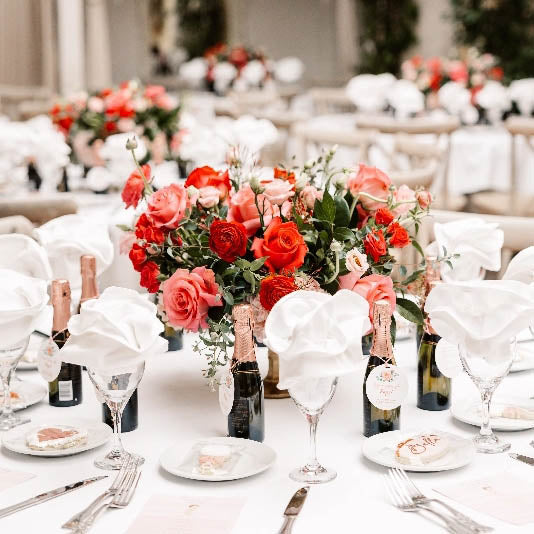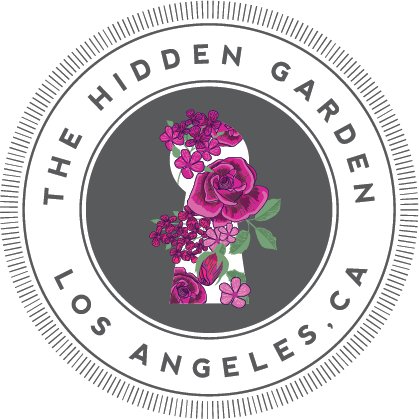
This guide covers August birth flowers and seasonal blooms that peak this month. You’ll get facts, care tips and styling advice for each one. Whether you’re sending flowers or using them in your own home, this will help you make better choices and get more out of every stem.
With over 25 years as a floral designer and owner of The Hidden Garden florist in Los Angeles, I’ve worked with August flowers for everything from private dinners to major televised events. I know what lasts, what looks good in a vase and what ends up being more trouble than it’s worth.
Keep reading if you want honest, useful advice on how to get the most out of August’s best flowers. Or check out this guide for the same information on July’s flowers.
Contents
-
August’s Birth Flowers
-
Flowers That Bloom During August And Their Symbolism
-
August Wedding Flowers
-
Popular Flower Gifting Occasions In August
-
Vibrant August Flowers From The Hidden Garden
August’s Birth Flowers
There’s a reason certain flowers are linked to birth months. Over time, people began connecting the bloom cycles and traits of each flower to the character of those born alongside them. August has its own set of flowers with meaning layered into every petal.
What I love most is how these choices turn a bouquet into something personal. When a flower reflects the month you were born, it carries a deeper kind of sentiment. It tells a story.
Below are the birth flowers forever linked to the month of August and what they mean.
Gladiolus
Photo credit Flickr.
Gladiolus is the primary birth flower for August. It makes sense when you think about the time of year. It’s one of the few that can handle the late-summer heat without fading. While other blooms start to drop off, gladiolus is just hitting its stride.
The reason it’s tied to August goes back to Roman history. Gladiolus comes from the Latin word for sword. Roman soldiers would wear them during battle. They believed it gave them strength. That image stuck. Over time, the flower became a symbol of moral strength and resilience.
Here’s a detail I love: Gladiolus doesn’t bloom all at once. The August Birth flower opens from the bottom up. It creates this beautiful rhythm that makes it really fun to work with. When I’m building a tall arrangement for an event, that gradual bloom gives me more options. It adds dimension. I used it last year for a film premiere. The clients wanted structure and elegance. Gladiolus helped anchor everything.
Symbolically this flower stands for integrity and emotional strength. It’s also linked to infatuation, which sounds dramatic, but I’ve seen that connection in real life. People born in August tend to love hard. That’s part of why I respect this August flower so much. It mirrors the people it’s meant to represent.
Gladiolus grows from corms, which are a little like bulbs. You’ll see it thrive in warmer climates with full sun. It’s native to South Africa but has found a home in gardens all across the US. In arrangements, I always remind people to keep the water clean and change it often. Gladiolus can be sensitive to bacteria. Also, don’t let pets nibble on it. It’s toxic to cats and dogs.
Red Poppy
Photo credit Flickr.
The red poppy, not white or pink, is the alternative birth flower for August. I’ve always found it interesting that August has two. Gladiolus gets most of the attention as a birth flower, but the red poppy is much more culturally significant globally. It carries deep meaning, especially in places like the UK and parts of Europe where it’s tied to remembrance and strength in the wake of the First Great War. Florists and flower lovers who know their history tend to prioritize this one.
After World War I, entire fields of red poppies grew where battles were fought. The soil had been turned over so violently that it triggered dormant seeds. It’s a reminder of how beauty can return even after devastation.
It’s a soft-looking flower with delicate petals but don’t let that fool you. It can grow in poor soil and still hold its color. The stems are slender and slightly hairy. The center is dark, which gives the red even more contrast. It’s native to Europe and Asia but has made its way into wildflower mixes all over the US. I’ve seen them thrive in California gardens with almost no help.
Due to the Red Poppy blooming in August it is considered an August birth flower as well as the state flower of California.
Recommended reading: Blooming Summer Flowers in California.
Flowers That Bloom During August And Their Symbolism
Daisy-like Asters (Callistephus chinensis / Michaelmas Aster
Photo credit Flickr.
-
Symbolic Meaning: Love, patience, elegance
-
Where It's Found: Widely grown in gardens across the Northern Hemisphere
-
Defining Features: Reaches 20–60 cm tall, with chrysanthemum-like heads in white, pink, purple, red
One thing I love about daisy-like asters, especially the Callistephus chinensis variety, is how their petals look almost painted on. I’ve used them in arrangements where people think they’re fake because the colors are so vivid and the symmetry is nearly perfect.
To learn more about summer flower colors, follow the link to access our floral guide.
The name “Michaelmas aster” comes from the feast of St. Michael, which falls in late September, right around the time these flowers are in full bloom. In England, they were often grown in monastery gardens. Queen Elizabeth I was even known to favor them in fall displays.
They’re annuals, not perennials, so you’ll need to plant new ones each year. But they bloom for weeks in late summer and early fall. If you’re growing them yourself, keep them in full sun with well-draining soil. Deadheading helps them last longer. And don’t overcrowd them. They need air circulation, especially in humid places, or they’ll mildew. I always tell clients, treat them like the stars of your garden, not your background August flowers.
Dahlia
Photo credit Flickr.
-
Symbolic Meaning: Commitment, elegance, inner strength
-
Where It's Found: Native to Mexico, now popular in ornamental beds globally
-
Defining Features: Showy, multi-petaled blooms in varied shapes and rich colors, peak in mid‑August
One detail people don’t expect is that dahlias were originally grown for food. The Aztecs used their tubers in cooking long before anyone thought to display the flowers. Now they’re known for elegance, but their history is rooted in utility.
Because they symbolize commitment and lasting grace, I think they’re perfect for marking a tenth wedding anniversary. Picture a low arrangement of blush dahlias on the dinner table, surrounded by candlelight, would say more than a card ever could.
To make them stand out in a bouquet, I usually pair them with dusty miller or ranunculus. The texture contrast keeps it interesting. Stick to one dominant color tone. Let the dahlia lead.
Zinnia
Photo credit Flickr.
-
Symbolic Meaning: Lasting affection, friendship, remembrance
-
Where It's Found: Cultivated worldwide in warm-season gardens
-
Defining Features: Bright, daisy-like heads on strong stems, often red, pink, orange, or yellow
Historical ties of zinnias trace back to the Aztecs in Mexico where the flower was grown by priests for ceremonial uses before European explorers brought it to Spain and later to North America in the 18th century. It gained popularity in Victorian-era gardens, admired for its vibrant palette and long-lasting blooms.
Their flowering season lasts from mid-summer until the first frost. They’re annuals, so you plant fresh seeds each year and enjoy weeks of color. In my experience they’re incredibly reliable for events that span several weeks.
Care for this August flower is straightforward. Give them full sun and well-draining soil. I remove spent blooms regularly and water at the base to avoid wetting the leaves. That helps prevent powdery mildew
I’ve noticed zinnias draw in bees and butterflies with enthusiasm. Their open centers make it easy for pollinators to gather nectar efficiently.
Chrysanthemum
Photo credit Flickr.
-
Symbolic Meaning: Joy, optimism, joy of life
-
Where It's Found: Garden borders and containers, especially in late summer
-
Defining Features: Pom-pom or daisy types up to 12 cm wide, in shades from white to crimson
The look of a chrysanthemum can fool people. From a distance, it might read simple. But up close, each petal is layered with detail. Some varieties are full and round. Others have long, spindly petals that curl in unpredictable ways. I like how they come in so many colors without needing to be dyed.
They represent loyalty and honesty. That makes them a good choice when someone has quietly stood by you through a hard chapter. I think of them on a kitchen counter, handed off with a few words after a long, emotional talk.
When I’m styling them, I like pairing them with seeded eucalyptus or cream roses. Let the texture lead. It doesn’t take much to make this August flower look polished, just space and a little balance.
In parts of Asia, people once used chrysanthemums to keep away bad spirits.
Recommend reading: Flowers In Mythology
Sedum
Photo credit Flickr.
-
Symbolic Meaning: Endurance, tranquility, resourcefulness
-
Where It's Found: Sunny, well-drained garden spots, hardy in temperate zones
-
Defining Features: Succulent leaves with flat clusters of pink-to-rust blossoms
One fun fact about sedum is its leaves can store water so well that it thrives in rock gardens and even on old walls without soil or extra care. That makes it a dependable choice for drought-resistant design.
Its history stretches back to medieval gardens where monks favored sedum for its hardiness. There’s a record of it being grown in abbey rooftop gardens in Europe, believed to bring balance to buildings and to those tending them. That mix of function and beauty is part of its charm.
It’s a perennial that blooms from late summer through autumn. You’ll get weeks of clusters of tiny flowers, often in soft pink or golden hues. Its blooming season bridges summer’s end into cooler weather making it one of the most long lasting August flowers.
Leaves on some sedum varieties have mild medicinal properties, once used in folk remedies to soothe minor skin irritations or digestive upset. It’s not common in modern herbalism but has roots in traditional use.
Agastache
Photo credit Flickr.
-
Symbolic Meaning: Wisdom, peace, attraction (to pollinators)
-
Where It's Found: North American prairies and garden plantings
-
Defining Features: 60–90 cm spikes of licorice-scented tubular flowers in purple or pastel
Agastache brings in pollinators like nothing else in my garden. I’ve watched bees dive straight into the spiky blooms before anything else opens. It’s the plant that keeps the whole area buzzing, literally. If I’m working on a garden-friendly event space, I’ll almost always work it into the background plantings for that reason alone.
Its scent is where it really surprises people. There’s a soft sweetness to it, but with mint tucked in behind it. Not sharp like peppermint. More like what you’d get steeping herbs in warm sun. I’ve brushed past it on accident and had guests stop just to figure out what they were smelling.
Give it sun, and don’t overwater. It hates wet feet. Cut it back in the fall and it’ll reward you in spring. I’ve seen it survive dry heat that wipes out fussier plants.
Because it’s tied to healing and clarity, it’s a thoughtful August flower gift for someone starting over. A friend leaving a difficult job to launch their own thing would feel understood getting this August flower.
Joe-Pye Weed (Eutrochium fistulosum)
Photo credit Flickr.
-
Symbolic Meaning: Healing, encouragement, abundance
-
Where It's Found: Moist meadows and pond edges in eastern North America
-
Defining Features: Tall (up to 2 m) stems topped with pinkish flower clusters loved by pollinators
Joe‑Pye weed doesn’t sound elegant, but the story behind it is worth knowing. It’s named after a Native American healer who used the plant to treat typhus in the 1700s. That kind of legacy stays with me. It’s not just about how a plant looks, it’s about where it came from and who trusted it.
It earned its place in early American gardens not just for its height or blooms, but because people relied on it. Settlers learned from Indigenous communities and passed that knowledge along. You’d see it this August flower behind houses or along property lines, somewhere close enough to reach if someone came down with a fever.
The roots and leaves were once brewed into tea for kidney problems and flu symptoms. I wouldn’t recommend doing that now, but I still see it as a flower with a story. And that gives it a different kind of beauty.
Joe‑Pye weed draws in pollinators like few other perennials. Its tall, dome-shaped blooms provide easy landing spots for bees, butterflies, and even hummingbirds. Monarchs seem especially drawn to it late in the season when they’re preparing for migration. The nectar is rich and accessible, and the long blooming period means a steady food source.
August Wedding Flowers
August calls for summer wedding flowers that capture the beauty of late summer and the changing season. I see a lot of requests for amaranthus, echinacea, and garden roses around this time. I’ve used them in everything from tiny elopements to huge ballroom setups, and they never disappoint.
Amaranthus

I’ve always liked using amaranthus in august flower weddings for couples who want their blooms to feel rich and resilient. The burgundy variety brings depth to the color palette and creates a sense of history, which fits well when a couple has been together for a long time before getting married
One way I like to use amaranthus is above the head table. I’ve done hanging installs with it draping down just enough to soften the space without blocking sight lines. It adds movement and helps bring the design upward, which is a smart way to frame the couple without needing a big backdrop.
Echinacea
Echinacea has a shape that brings contrast in a way most August wedding flowers don’t. It’s spiky in the center with simple petals around it and that makes it stand out next to more traditional blooms.
I’ve brought echinacea into rehearsal dinner centerpieces when the couple wants a different look from the wedding day but still wants everything to feel related. Paired with taper candles and looser greenery, it gives a more relaxed mood without losing the sense of design.
Garden Roses

The Hidden Garden's Infinite Love
I’ve worked with garden roses, which are in my view the primary August wedding flower, for decades and they still stop people in their tracks. They’re fuller than standard roses and when you choose a soft apricot shade, they give off a warmth that reads as intimate and welcoming. That tone carries meaning too. It signals friendship and joy, which makes it perfect for weddings where family is deeply involved.
One moment I love for garden roses is the transition from ceremony to dinner. I’ve reused aisle flowers and tucked them into escort card displays or entry pieces at the reception. It makes the flow between spaces feel smoother and connected.
Popular Flower Gifting Occasions In August
-
National Sisters Day – First Sunday in August: A time to show appreciation with thoughtful flowers between siblings. Perfect occasion for gifting the August birth flowers: Gladiolus and Red Poppy.
-
National Friendship Day – First Sunday in August: Friends often exchange small gestures or floral gifts to mark the bond. View our friendship flowers product collection.
-
Victory Day – Second Monday in August (Rhode Island): A state holiday in Rhode Island marking the end of World War II after Japan's surrender. Flowers or small tokens may be shared in remembrance.
-
Statehood Day (Hawaii) – Third Friday in August: Celebrates Hawaii’s admission into the Union in 1959. State offices are closed, and locals may exchange gifts or flowers in honor of the occasion.
-
Women’s Equality Day – August 26: Commemorates the 1920 adoption of the Nineteenth Amendment granting women the right to vote. Often recognized with symbolic gifts or August flowers to honor progress and empowerment.
-
Lyndon Baines Johnson Day – August 27 (Texas): Recognizes President Johnson’s birthday as a legal holiday in Texas. Some residents might mark it with gifts or plants.
Vibrant August Flowers From The Hidden Garden
Brighten your space with bold, seasonal blooms that capture the heart of summer. Whether you're celebrating a milestone or just want to bring color into your home, our August flowers are full of texture and personality.
From radiant gladiolus to delicate asters, every arrangement is made with care and style. Explore our handpicked summer flower arrangements by following the link.

